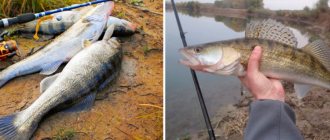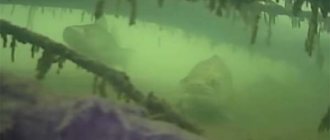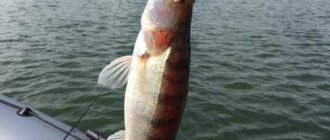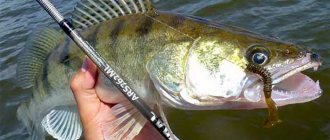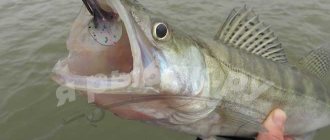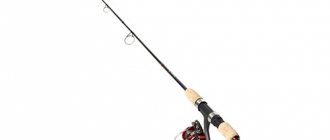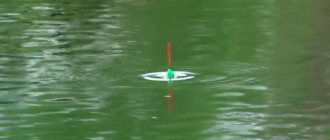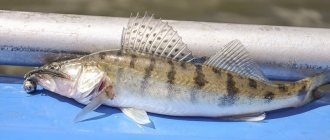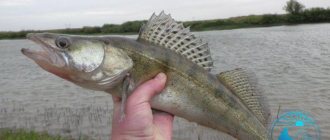How to catch pike perch using a spinning rod in different bodies of water, where to start and what gear will you need? These questions are asked by many fishermen, even experienced ones, who have some difficulties in hunting for this valuable and special predator. Catching a fanged one has always been considered an indicator of a certain skill and experience in the spinning direction, and the fish itself is valued not only for the characteristics of its catching, but also for its gastronomic qualities. Few underwater river inhabitants can compare in taste to pike perch. Anyone who has tried the aspic made from this fish will understand...
Many beginning spinning anglers who want to catch pike perch must first learn to understand and know:
- Features of his behavior.
- Typical camping and hunting sites.
- Seasonal preferences of fish.
- The right approach to choosing gear and pike perch baits.
- Tactical and technical nuances and secrets of fishing.
In general, the question of how to catch pike perch using a spinning rod is not that difficult. Having studied the topography of a potentially catchable area and selected baits, you can count on regular catches, even without extensive experience in hunting fanged fish.
Features of the behavior of pike perch when fishing with spinning rods
When is the best time to catch pike perch using a spinning rod is a controversial question. Pike perch is an all-season predator. Hunting for it can be started in early spring immediately after the rivers are freed from ice cover. Avid walleye fishermen continue to fish throughout the “liquid” water season and close it only just before freeze-up. In winter, the fanged fish continues to feed; in non-freezing areas, fishing for it with a spinning rod continues. Successful fishing can also be done from under the ice.
In early spring, the predator behaves passively, it is not easy to catch it, you have to look for active fish, the best bait and its optimal presentation. As the water warms, pike perch begins to move to spawning grounds - the spring pre-spawning feast begins. It usually falls at the end of April - beginning of May. This is the most favorable time for spring hunting for pike perch.
Then the predator begins to spawn and its appetite decreases significantly. This apathy lasts until the beginning of summer, when the behavior of pike perch enters a new phase. During this period, the best fishing is considered to be night fishing, which takes place on spits and shallows. The fanged one goes out into shallow water, where it actively eats small fish - bleak, perch, roach, chub and other small things. The most effective way at this time is to catch pike perch in July using spinning wobblers. This behavior lasts until mid-August. Then, as the air temperature cools and the water cools, the pike perch switches to the autumn feeding mode, moving to traditional deep and snagged places.
In the fall, the most stable and interesting stage in the hunt for fangs begins. Pike perch is active throughout the autumn period. It is caught on many large and medium-sized rivers, large lakes and reservoirs. An article on how to catch pike perch in October is here. As winter approaches, the predator's appetite fades, but it continues to peck almost until freeze-up.
Depending on the month
December
The first ice is the best time for fishing for pike perch. Several circumstances favor this:
- a sufficient amount of oxygen dissolved in water;
- zhor that continues from autumn;
- the formation of flocks and the resulting food competition.
At the same time, the ice is not yet so thick, the fisherman spends less effort drilling a large number of holes. Good fishing is also facilitated by the fact that the fish are still in their usual “summer” places, and knowing them, it is easier to stumble upon a fattening school. Often on the first ice there are several bites in a row in one hole. This is especially noticeable when the size of the pike perch does not exceed one and a half kilograms.
During the first ice season it bites best in the morning and evening dawns; rarely in cloudy weather it can be caught throughout the daylight hours.
In January
The frosts are becoming stronger, the ice is thicker, and deep winter is setting in. Schools of walleye move to areas where dissolved oxygen levels are higher:
- at the channel current;
- places of confluence of tributaries;
- to the springs.
At the same time, the predator is active and continues to feed, albeit with less intensity than during the first ice. He no longer rushes at everything, but carefully selects the offered bait.
Having a reliable team is even more important during this period than during the first ice season. Since the ice is quite thick, you should choose your fishing spot more carefully so as not to waste energy drilling unpromising holes. We increasingly have to use technical equipment:
- motorized dogs and snowmobiles for transportation;
- echo sounders for terrain research;
- motorized ice drills to facilitate the work of making holes.
But now you can fish throughout the daylight hours. The ice cover itself became thick, and even a layer of snow enveloped it. So there was almost constant twilight at the bottom. In this regard, baits need to be chosen that are brighter and visible from afar. In this case, the fishing line can be used a little less thick. A pike perch, which is picky in the deep winter, may simply not approach what, from its point of view, is a thick rope hanging from the ice itself.
In February
The February thaws bring some variety to the behavior of all underwater inhabitants. Small streams of melt water still penetrate under the ice, so the search area expands. It is now shifting towards the tributaries.
But still, by February, the pike perch has lost a lot of stored nutrients, and is not inclined to spend a lot of energy for hunting. A distinctive feature of the predator’s diet at the end of winter is a short, quick grip. This is why every bite and quick hook is so important. Therefore, the number of gears is reduced and they rely more on active fishing with constant control of the gear.
In this case, fishing should take place forcedly on a stretched line. If you give the fanged one even a modicum of freedom in the form of a weakened fishing line, he will gladly pull it into the nearest snag.
In February, gear is further minimized. Fishing lines are now set with a diameter of 0.20-0.22 millimeters, and sometimes even thinner, relying only on a well-functioning friction brake of a high-quality reel.
Which model to use is up to each angler to decide for himself. Some people choose an inertia-free “meat grinder”, others like a modern multiplier, while others work well with a simple inertia machine.
The size of the baits also changes downward. If spinners up to ten centimeters long were placed on the first ice, now, in February, it is better to use a perch set - from four centimeters.
The game with lures is also undergoing changes. Now you should not make sudden movements. The raising and lowering of baits is made more measured, the number and duration of pauses are increased.
Despite the great depth at the fishing point, you must remember to be careful with the fish:
- do not create a lot of noise;
- do not expose the clearing, mask the holes with snow.
Places to look for pike perch when fishing with a spinning rod
There is nothing to do without knowledge of pike perch sites and points on the reservoir. The fanged one is a sedentary predator that does not constantly move around the reservoir, but prefers to be in the area of its favorite places. Occasionally, pike perch makes forays into nearby shallows, hills or edges, then returns to the shelter again.
Typical sites for fanged predators are:
- Channel dumps.
- Deep riffles.
- Sharp eyebrows.
- Areas with uneven, chaotically changing terrain.
- Snags or single flooded massive tree trunks and large branches.
- Deep holes, long channel ditches and local pits with sufficient depth.
- Hydraulic structures, especially bridge supports.
- Rocky ridges and embankments designed to strengthen river banks.
- Steep banks with a pressure current and a sharp drop into the riverbed.
Pike perch loves currents and clean, oxygenated water. This fish will never stand in stagnant places where the water is muddy or blooming. Also, the predator cannot be found on the muddy, swampy bottom. It prefers firm areas with sandy and rocky texture.
Spinning rod equipment for pike perch
It is better to equip a spinning rod for casting pike perch with a spinning reel or a multiplier casting reel. But fishing with a baitcasting reel is more difficult, since if the settings are not correct and without experience in use, when casting, there is a high probability of a beard appearing on the reel, and then a long and tedious unraveling of the fishing line. And it is also necessary to take into account that a good quality multiplier casting reel is much more expensive than a spinning reel.
It is better to choose a spinning reel that is also durable and of high quality, size 2000-4000, depending on the test of the spinning rod and the bait. To equip the reel, you can wind a fishing line with a diameter of 0.27-0.35 mm or a cord 0.8-1.2 (0.14-0.20 mm thick), whatever is convenient for you and always taking into account the characteristics of the fishing rod.
It is better to fasten the bait to a fishing line or cord using a metal leash with a clasp. It is preferable to use a titanium leash, without memory, 15-20 cm long. Because when casting, a pike can bite and cut off your favorite and expensive wobbler or spinner with its teeth. And be sure to remember to install a swivel between the fishing line and the leash.
During this period, the bait is small in size, with a jig head weight of no more than 25 g. The rod is reliable, with a fast action and a length of 2.5 to 3 meters. The thickness of the fishing line is in the range of 0.15-0.2 mm. To interest a pike perch that has not yet fully awakened from hibernation, you should perform a stepwise retrieve, making short but sharp movements. For a better and more pronounced game, you should connect a rod to the wiring process.
Choosing gear for catching pike perch
How to properly catch pike perch using a spinning rod, what are the main methods and what gear to choose? The main and basic direction in pike-perch fishing is jig. Today this method is not a secret to anyone. Much has been written about it, and the fishing market is saturated with specialized rods and lures, suitable reels and lines.
You can hunt fangs either from the shore or using a boat. Both options are fun and, when done properly, produce consistent results. In general, the selected spinning set should provide maximum sensitivity when retrieving and fixing a bite, and also allow you to powerfully hook the fish and fish it out in a forceful style.
How to catch pike perch using a spinning rod from the shore, with what gear:
- Spinning rod – 2.70 meters long, fast or medium-fast action.
- Reel size 2500–4000, power with a reduction of about 1:5.0.
- A cord with a diameter of 0.10–0.18 mm with sufficient breaking strength, good abrasion resistance and a smooth structure for long-distance casting.
The abrasive resistance of braid is important, since you often have to fish in snaggy places or on the bottom densely strewn with shell rock. The last couple of meters of the cord are constantly in contact with underwater obstacles, losing strength, which can lead to breakage when landing even a small specimen. Therefore, many seasoned pike-perch fishermen use a steel, or less often fluorocarbon, leader. Pike perch fangs are not capable of significantly damaging the fishing line, but the leash will save it from chafing when it comes into contact with flooded branches and shell rock.
The kit for catching fanged fish from a boat does not differ significantly from shore-based gear. The choice of spinning rod should be based on the fact that long-distance bait casting is not required here. The fishing rod is selected with a length of about 2.10 meters of fast action with a large reserve of power for forced pumping out of pike perch when fishing in difficult conditions.
When fishing for pike perch using other methods and methods, the use of a jig kit is allowed. For example, such gear is suitable for fishing with spaced rigs or with minnow wobblers during night summer forays onto the river. For crank wobblers, it is more advisable to take a medium-action rod, which will allow you to work better with lures of this class.
About spinning fishing
The modern market offers a colossal assortment of jig fishing rods, but the best spinning rod for pike perch will have the following qualities:
For fishing from the shore
- From 2.6 to 3 meters in length
- Range of baits used: 15-40 grams
- Blank action: medium-fast, for long-range shooting
- Minimum weight for comfort during intensive fishing
For fishing from a boat
- Length about 2.1 m
- Range of baits used: 50-60 grams
- Blank construction: fast, to speed up the removal of fish from snags
If you watch a couple of videos on thematic channels of professionals catching pike perch with a spinning rod, most of them will use expensive equipment from famous manufacturers, but a beginner should not follow their example, and it is better to learn the basics of spinning fishing on more budget models so as not to risk their own funds.
What baits to catch pike perch on a spinning rod
The fanged underwater inhabitant is most often caught with silicone baits. Today, the fishing market is replete with a variety of models, types and colors of lures. Along with traditional twisters and vibrotails, various worms, nymphs, crustaceans and other creatures that imitate underwater insects, their larvae or even some strange objects have become extremely popular.
Fishing with soft rubber worms is especially interesting. They come in two types:
- Active with a movable twister tail.
- Passive, not having their own game.
With the first type of silicone worms everything is clear. You can fish with them in the same way as using twisters and other moving baits. Passive baits work great against a sluggish predator that does not want to attack fast-moving underwater objects. By using different methods of wiring, you can entice the sleepiest predator and force it to peck. Such baits are used not only in classic jig rigs. They are applicable in lead leash, drop shot, Carolina, split shot, Texas and others.
Another effective pike perch bait is a foam fish. It has been known to our spinning players for a long time; it was invented long before the advent of silicone. Foam rubber baits work better in cold water and can be used in difficult to navigate places. Possessing low windage and impressive flight performance, foam fish solve the problem of how to catch pike perch with a spinning rod from the shore in the fall at long and ultra-long distances.
Spoons for catching pike perch using a spinning rod
Rotating spoons are also used for catching fanged lures. More often, front-loaded spinners are used, which can be used to fish with jigs. Their advantage is active and noisy work, and as a result they are visible to predators. The disadvantage is the inability to fish difficult-to-pass places due to the catchiness of the bait. Back-loaded spoons can be seen extremely rarely in pike-perch fishing. Their use is advisable for night pike perch hunting in shallows or in exceptional cases when the fish does not feed at depth or in surface layers of water.
In rare cases, narrow-bodied oscillating spinners can be observed in pike perch boxes. Such baits are also capable of seducing a fanged predator. However, their use is limited by the cleanliness of the fishing area. They are not suitable for snags in ponds due to frequent snags. But when fishing distant channel edges with a clean bottom, they have no equal.
Wobblers for catching pike perch using a spinning rod
Cranks are used more often in boat fishing. Since deep-sea series are used, it is uncomfortable to carry them out from the shore; they will cling to the shore edge, and other obstacles and cliffs cannot be avoided. The main thing in hunting for pike perch with crank wobblers is to choose a model that, when reeling, will periodically strike the bottom, raising a cloud of turbidity and simulating a fry swarming at the bottom.
Minnows are used only in summer fishing for pike perch using a spinning rod. They are effective in night fishing on spits, shallows and shallow riffles. In other cases, baits in this category do not work.
What methods are used for fishing?
This number of gear includes:
- float rod;
- donku;
- girders;
- mugs.
Let's look at each of the methods in more detail.
On a float rod
The equipment looks like this:
- Rigid match, Bolognese rod. Working length is 3–4.5 m.
- The coil is taken to be inertialess. Size from 2000 to 2500.
- A piece of monofilament fishing line 40–50 m with a diameter of 0.25–0.3 mm.
- Olive shaped sliding sinker. Weight – from 8 to 12 g.
- Leash – 1 m with a single hook size No. 2/0.
- A large float that will slide freely along the fishing line.
After casting, the sinker should sink to the bottom. The position of the float is adjusted so that it lies on the water. This minimizes the influence of waves and strong wind on the float, and the bite will become noticeable from a long distance.
On the donk
Bottom equipment has its own characteristics:
- A rigid spinning rod with a length of 2.4 to 3 m. An alternative is a feeder rod with a length of 3.6–3.9 m.
- Monofilament line 0.35 mm thick.
- The reel is inertialess. Size – 3000.
- The sinker is flat with special protrusions for fastening. Weight – from 80 to 110 g.
- Carbine with swivel. Attaches to the end of the main line.
- Monofilament leash. Length from 70 to 100 cm. Thickness from 0.27 to 0.3 mm. Single hook – No. 2/0 or 1/0. The leash is fixed 25 cm above the sinker.
- Bite alarms are either electronic or a budget option - ordinary bells.
To the girders
Used near the shore, among snags, among pools, and algae. A zherlitsa is a wooden slingshot. A monofilament with a diameter of 0.3 mm is wound onto it. A piece from 10 to 15 m is enough. The sinker is taken with a sliding weight of up to 10 g. The leash is from 80 to 100 cm.
Fishermen often make zherlitsa right on the pond. Depending on the region, 1 fisherman is allowed to use from 1 to 10 girders at the same time, installing them in different places. Using several pieces significantly increases the chances of catching.
For mugs
A universal type of bottom tackle. Can be used both in still water and in currents. Fishermen also call the mugs “floating girders.” They consist of the following elements:
- A circle with a diameter of 15 cm and a thickness of 2–2.5 cm is cut out of foam plastic. Neat protrusions are made on both sides for fixing and winding the fishing line.
- A piece of monofilament fishing line from 10 to 15 m long with a diameter of 0.3–0.35 mm.
- Sinkers are taken weighing 8–12 g.
- Leash length – from 30 to 50 cm. Single hook – No. 2/0 or No. 3/0.
- If fishing is planned on a river, then additional equipment with a triple swivel is made. A leash and a piece of monofilament with a flat weight weighing from 40 to 60 g are tied to its 2 rings.
